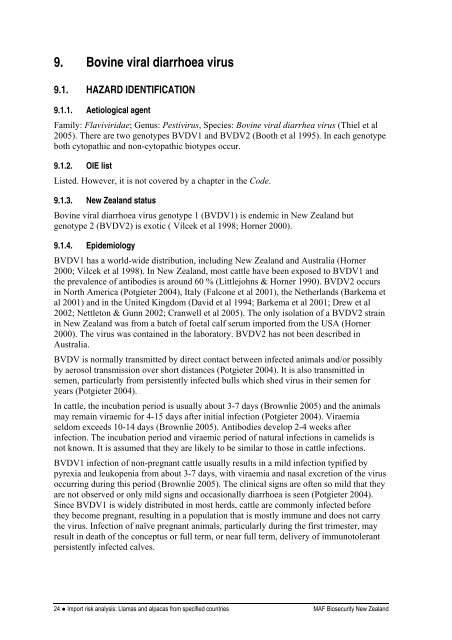Import risk analysis: Llamas (Lama glama) and alpacas (Vicugna ...
Import risk analysis: Llamas (Lama glama) and alpacas (Vicugna ...
Import risk analysis: Llamas (Lama glama) and alpacas (Vicugna ...
You also want an ePaper? Increase the reach of your titles
YUMPU automatically turns print PDFs into web optimized ePapers that Google loves.
9. Bovine viral diarrhoea virus<br />
9.1. HAZARD IDENTIFICATION<br />
9.1.1. Aetiological agent<br />
Family: Flaviviridae; Genus: Pestivirus, Species: Bovine viral diarrhea virus (Thiel et al<br />
2005). There are two genotypes BVDV1 <strong>and</strong> BVDV2 (Booth et al 1995). In each genotype<br />
both cytopathic <strong>and</strong> non-cytopathic biotypes occur.<br />
9.1.2. OIE list<br />
Listed. However, it is not covered by a chapter in the Code.<br />
9.1.3. New Zeal<strong>and</strong> status<br />
Bovine viral diarrhoea virus genotype 1 (BVDV1) is endemic in New Zeal<strong>and</strong> but<br />
genotype 2 (BVDV2) is exotic ( Vilcek et al 1998; Horner 2000).<br />
9.1.4. Epidemiology<br />
BVDV1 has a world-wide distribution, including New Zeal<strong>and</strong> <strong>and</strong> Australia (Horner<br />
2000; Vilcek et al 1998). In New Zeal<strong>and</strong>, most cattle have been exposed to BVDV1 <strong>and</strong><br />
the prevalence of antibodies is around 60 % (Littlejohns & Horner 1990). BVDV2 occurs<br />
in North America (Potgieter 2004), Italy (Falcone et al 2001), the Netherl<strong>and</strong>s (Barkema et<br />
al 2001) <strong>and</strong> in the United Kingdom (David et al 1994; Barkema et al 2001; Drew et al<br />
2002; Nettleton & Gunn 2002; Cranwell et al 2005). The only isolation of a BVDV2 strain<br />
in New Zeal<strong>and</strong> was from a batch of foetal calf serum imported from the USA (Horner<br />
2000). The virus was contained in the laboratory. BVDV2 has not been described in<br />
Australia.<br />
BVDV is normally transmitted by direct contact between infected animals <strong>and</strong>/or possibly<br />
by aerosol transmission over short distances (Potgieter 2004). It is also transmitted in<br />
semen, particularly from persistently infected bulls which shed virus in their semen for<br />
years (Potgieter 2004).<br />
In cattle, the incubation period is usually about 3-7 days (Brownlie 2005) <strong>and</strong> the animals<br />
may remain viraemic for 4-15 days after initial infection (Potgieter 2004). Viraemia<br />
seldom exceeds 10-14 days (Brownlie 2005). Antibodies develop 2-4 weeks after<br />
infection. The incubation period <strong>and</strong> viraemic period of natural infections in camelids is<br />
not known. It is assumed that they are likely to be similar to those in cattle infections.<br />
BVDV1 infection of non-pregnant cattle usually results in a mild infection typified by<br />
pyrexia <strong>and</strong> leukopenia from about 3-7 days, with viraemia <strong>and</strong> nasal excretion of the virus<br />
occurring during this period (Brownlie 2005). The clinical signs are often so mild that they<br />
are not observed or only mild signs <strong>and</strong> occasionally diarrhoea is seen (Potgieter 2004).<br />
Since BVDV1 is widely distributed in most herds, cattle are commonly infected before<br />
they become pregnant, resulting in a population that is mostly immune <strong>and</strong> does not carry<br />
the virus. Infection of naïve pregnant animals, particularly during the first trimester, may<br />
result in death of the conceptus or full term, or near full term, delivery of immunotolerant<br />
persistently infected calves.<br />
24 ● <strong>Import</strong> <strong>risk</strong> <strong>analysis</strong>: <strong>Llamas</strong> <strong>and</strong> <strong>alpacas</strong> from specified countries MAF Biosecurity New Zeal<strong>and</strong>

















